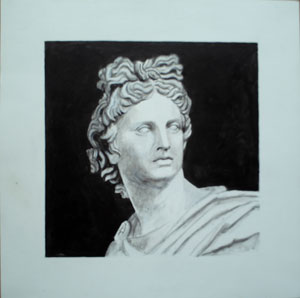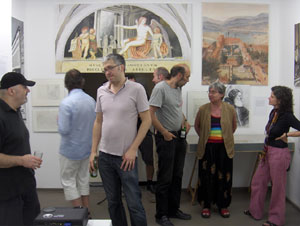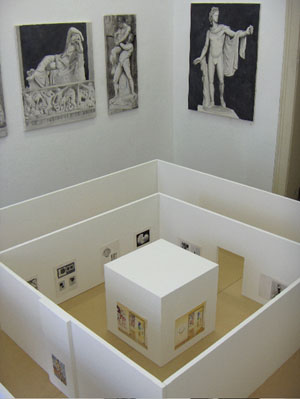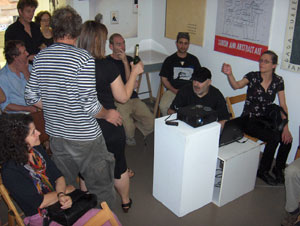(english)
Die Ausstellung "SITES OF MODERNITY" thematisiert die Entwicklungsgeschichte
jenes Narrativs, aus dem sich unser Verständnis der Modernität
herausgebildet hat. Ausgangspunkte dafür sind zwei Museen; das erste,
das Belvedere Romanum im Vatikan, und das letzte, das Museum of Modern
Art (MoMA) in New York.
Zur Zeit ihrer Entstehung standen beide Museen für eine neue Sichtweise
der Vergangenheit und waren die wichtigsten Impulsgeber für einen
differenzierten Umgang mit der Kunst. Aus heutiger Sicht präsentiert
"SITES OF MODERNITY" beide Institutionen als Museen der Antiquitäten.
Die Ausstellung wird mit dem Vortrag "MoMA and the International
Program" von Herrn Porter McCray, dem Mitarbeiter des Museums of
American Art in Berlin, eröffnet.

Kazimir Malevich: "Apollo", 1985*






SITES
OF MODERNITY - Belvedere Romanum and Museum of Modern Art
Eröffnung: Freitag,
27. Juni 2008, 19.00 Uhr
Besichtigung der Ausstellung bis 14.07.2008
Mo 21.30 - 24h, und nach Vereinbarung unter Tel: 0176-51025827
Im Rahmen der Ausstellung findet am Samstag, den 28. Juni 2008, um 18 Uhr
ein Vortrag von Vivant Denon im Württembergischen Kunstverein statt, der
sich mit dem Belvedere Romanum im Vatikan auseinandersetzt.
Besichtigung der Ausstellung bis 14.07.2008
Mo 21.30 - 24h, und nach Vereinbarung unter Tel: 0176-51025827
Im Rahmen der Ausstellung findet am Samstag, den 28. Juni 2008, um 18 Uhr
ein Vortrag von Vivant Denon im Württembergischen Kunstverein statt, der
sich mit dem Belvedere Romanum im Vatikan auseinandersetzt.
Sites
of Modernity
Some time around the year 1503, Pope Julius II placed the Apollo statue, which was in his possession, into the newly built Vatican garden named Belvedere. Soon after, the Laocoon group was excavated and brought to the garden as well. Then came other statues: Torso, Nile, Cleopatra, Venus, Comodus as Hercules, Tiber,... Those had been mostly broken marbles scattered around in various private palaces or buried for many centuries. Now, put on display together in the enclosed garden, they became exhibits, as if in an open-air wonder camera. Unlike the other wonder camera collections, this one was dedicated solely to the statues from ancient times. Those fragments from the past, placed among the orange trees and in specially built niches, emerged as a completely new sight for the contemporaries. This was something that had never been seen before. Soon it got the name Antiquario delle Statue, and that was the moment when the Antiquity was born. However, this particular display of the statues from the past became also the new vision of the past. Being the most nouvelle invention of the time, this represents the birth of Modernity as well. Those statues were the first works of art and the first modern works of art. Thus the Belvedere Antiquarium itself was not only the first museum of art, but also the first museum of modern art. Since that moment, the Antiquario dell Statue, directly or indirectly, shaped the concept of art and art institutions throughout the entire Western World, for the next five centuries.
In 1929 The Museum of Modern Art opened in New York. After Pio-Clementino and the Louvre museums, this was the last important offspring of the Belvedere impulse. Being international in scope, the idea of Modern was to collect and exhibit the best and most advanced art of the time. At the 1936 exhibition Cubism and Abstract Art, instead of the dominant 19th century paradigm based on National Schools, the museum's founding director
Alfred Barr introduced the idea of International Movements. This completely changed the character of the modern art narrative, and retroactively, the History of Art in general. And this is the narrative that has been shaping the art world ever since.
Today the old Belvedre collection of statues is in the Vatican Museum, while the most important collection of modern art is in the Museum of Modern Art. And today these two museums are both museums of antiquities. The exhibition Sites of Modernity brings together to life the fading memories on these two most important museums of modern art: Belvedere Romanum and Museum of Modern Art.
*) Malevich's painting "Apollo" from his recent exhibition "Autobiography"
is borrowed for this exhibition since it brings together the Apollo Belvedere
and the Black Square, the first and, one could say, the last modern work of art.
Saturday, June 28, 2008, 6 pm
Württembergischer Kunstverein
Some time around the year 1503, Pope Julius II placed the Apollo statue, which was in his possession, into the newly built Vatican garden named Belvedere. Soon after, the Laocoon group was excavated and brought to the garden as well. Then came other statues: Torso, Nile, Cleopatra, Venus, Comodus as Hercules, Tiber,... Those had been mostly broken marbles scattered around in various private palaces or buried for many centuries. Now, put on display together in the enclosed garden, they became exhibits, as if in an open-air wonder camera. Unlike the other wonder camera collections, this one was dedicated solely to the statues from ancient times. Those fragments from the past, placed among the orange trees and in specially built niches, emerged as a completely new sight for the contemporaries. This was something that had never been seen before. Soon it got the name Antiquario delle Statue, and that was the moment when the Antiquity was born. However, this particular display of the statues from the past became also the new vision of the past. Being the most nouvelle invention of the time, this represents the birth of Modernity as well. Those statues were the first works of art and the first modern works of art. Thus the Belvedere Antiquarium itself was not only the first museum of art, but also the first museum of modern art. Since that moment, the Antiquario dell Statue, directly or indirectly, shaped the concept of art and art institutions throughout the entire Western World, for the next five centuries.
In 1929 The Museum of Modern Art opened in New York. After Pio-Clementino and the Louvre museums, this was the last important offspring of the Belvedere impulse. Being international in scope, the idea of Modern was to collect and exhibit the best and most advanced art of the time. At the 1936 exhibition Cubism and Abstract Art, instead of the dominant 19th century paradigm based on National Schools, the museum's founding director
Alfred Barr introduced the idea of International Movements. This completely changed the character of the modern art narrative, and retroactively, the History of Art in general. And this is the narrative that has been shaping the art world ever since.
Today the old Belvedre collection of statues is in the Vatican Museum, while the most important collection of modern art is in the Museum of Modern Art. And today these two museums are both museums of antiquities. The exhibition Sites of Modernity brings together to life the fading memories on these two most important museums of modern art: Belvedere Romanum and Museum of Modern Art.
*) Malevich's painting "Apollo" from his recent exhibition "Autobiography"
is borrowed for this exhibition since it brings together the Apollo Belvedere
and the Black Square, the first and, one could say, the last modern work of art.
Saturday, June 28, 2008, 6 pm
Württembergischer Kunstverein
Antiquario dell Statue - Belvedere Romanun
Lecture by Vivant Denon